Rideway wrote:
Thanks a lot for posting your simulation input values, it helps to clarify it a lot but I still dont know how you got those 0.27 kg/s
Lets say that your exhaust gas inlet temperature is ok (by inlet i refer it as it is defined in a CFD simulation). For those 926ºC, you have for that temperature a density of 0.292 kg/m^3. Ok.
Liter per second is always volume flow rate. So to get mass flow rate you multiplied that volume flow rate by your density, that means:
Mass flow = 450 l/min * 0.292 kg/m^3 / 1000 l/m^3 which gives a mass flow of 0.1314 kg/s. Before you said 225 l/min wich even gives a mass flow of 0.0657 kg/s.
The 0.1314 kg/s is exactly the half of what you used, are your parameters refering to both exhausts? In that case it makes more sense to me. But then i guess you didnt use simmetry (geometry is symmetric, flow mustnt be compulsary symmetric).
Cheers
I think you are missunderstanding what I meant.
Let me give an example.
I am going to buy a Sullair compressor.
I have a packing machine which needs air at 90 psi that consumes 23 SCFM.
The "S" in SCFM means the flow rate at standard temperature and pressure. That describes the air volume flow that is sucked INTO the compressor at standard conditions before it is compressed.
This SCFM is easily measured because you can attach a realitively simple device in the the compressor intake line to measure the air flow.
It is unlikely to calculate the 90psi air flow in the actual high pressure air lines to the packing machine. So machines only give air flow in SCFM or NL/s specs.
Now if you are still following:
The data I got from williams is 450 liters per second at
standard conditions going INTO the engine. I cannot translate this to the exhaust because the exhaust is not at standard temperature and pressure. I have to use a mass flow rate instead as that is constant no matter what pressure changes occur in the pipe lines.
To get the mass flow rate:
Mass flow rate = Density x volume flow rate
Mass flow rate = 450/2 liters per second x 1.225 kg/m^3
Mass flow rate = 0.2756 kg/s
So 0.2756 kg/s is my
Input boundary condition at the exhaust pipe exit along with a temperature of 850*C and turbulence intensity.
And these are the
calculated Results by the program, after the simulation, at the exhaust exit
Pressure: 1.0067 bar
Density: 0.292 kg/m^3 (at normal conditions this is 1.225 kg/m3)
Velocity = 209.74 m/s
Mac number = 0.31
Temperature = 926*C (I think this is fluid reheating)
Volume flow rate: 0.924 m^3/second


